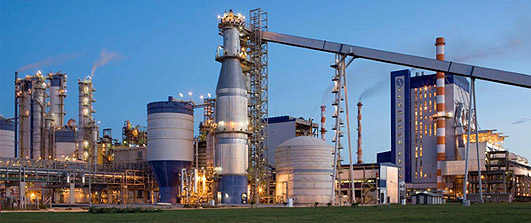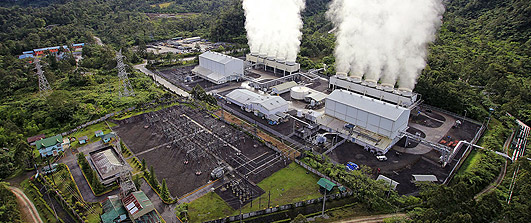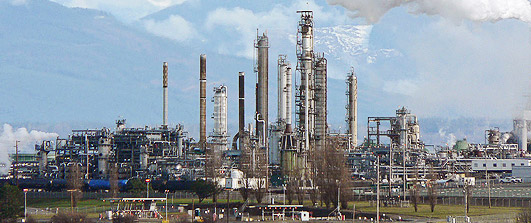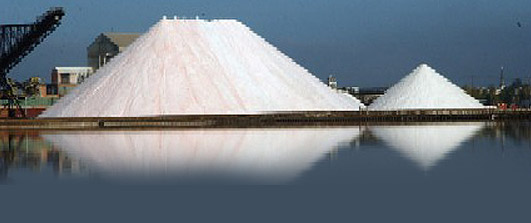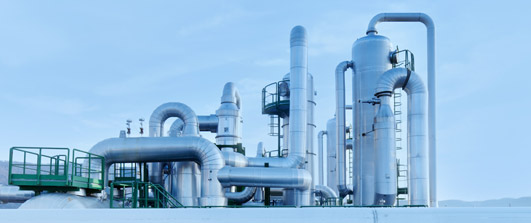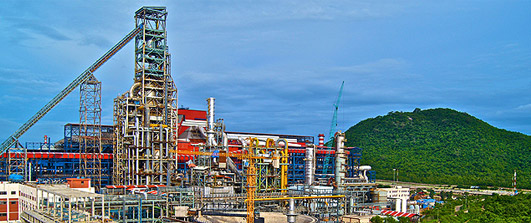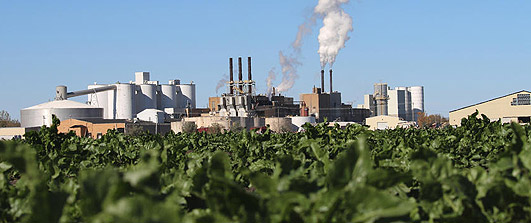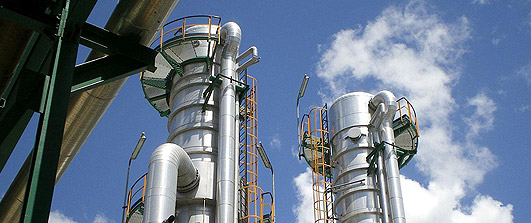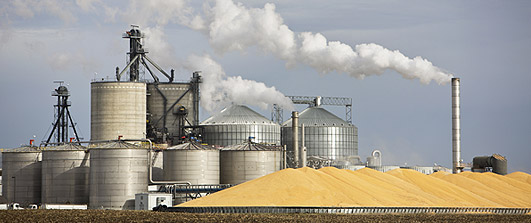PULP AND PAPER INDUSTRY
EVAPORATORS AND CONCENTRATORS are used to evaporate chemical liquor during the chemical recovery process of chemical pulping. The chemical pulping processes are the kraft, soda, sulfite, or semi chemical process. The kraft process, also known as the sulfate process, uses sodium hydroxide as the process chemical and is the most common form of pulping. The cooking liquor is known as black liquor.
Evaporators may be falling film plate, falling film tubular, rising film tubular, or multi-effect MVR. The first three types of evaporators use only steam, and either the AIROL® 120H875 or the AIROL® 430H125 mist eliminator is used for chemical recovery black liquor evaporation applications for pulp dissolving/papermaking and lignin production, and will return the highest efficiency, as explained below.
Evaporators customarily are used successively in series known as multiple effect evaporators with decreasing temperature and pressure from one effect to the next. The vapor boiled off in one effect is used to heat and boil the liquor in the next effect, and only the first of the vessels at the highest temperature requires an external source of heat. This process maximizes steam economy. CTI mist eliminators at the back end of each effect prevent droplets of concentrated liquor from being conveyed with the outlet steam to the steam chest of the following effect where it could foul the steam side of the following heat exchanger and contaminate its condensate.
More >>>
Efficiency typically is measured by the amount of sodium carried with the steam into the next effect or downstream condenser. The carry-over is affected by the mist eliminator inlet liquor rate, total dissolved solids in the black liquor, the pressure (resulting velocity), and the style of chevron. In vertical flow applications, 30-40 ppm sodium in condensate following separation is not uncommon, and in horizontal flow, 10-30 ppm sodium is not uncommon.
Because falling film plate type evaporators have lower exit steam velocity off the plate edges, larger droplets are formed, many of which drop out before reaching the mist eliminator. Due to the larger droplets and lower re-entrainment rate, the AIROL® 120H875 vertical flow chevron is the natural choice, providing both an economic and a high efficiency solution.
In tubular evaporators, steam coming out of the tubes is at a much higher velocity, generating finer droplets. In this case, the AIROL® 430H125 is more commonly used. Horizontal flow chevrons are selected for both falling film and rising film tubular evaporators because:
- They are more fouling resistant,
- They can handle higher liquid rates, and,
- They achieve higher efficiency.
The AIROL® 430H125 is sometimes chosen as a more conservative and efficient option for falling film plate evaporators as well, where a shorter and less expensive evaporator is desirable.
When debottlenecking is a concern, or when retrofitting an existing evaporator with insufficient space for an internal mist eliminator, an external in-line mist eliminator, such as the AIROL®430H125 or AIROL® 440H125 is the solution. (See Technical Bulletins, White Papers, Evaporator De-Bottlenecking PDF.)
CTI mist eliminators are installed worldwide in hundreds of evaporators and concentrators.
LIME KILN SCRUBBERS are used in paper mills to produce quicklime from carbonates as part of the chemical recovery process in the causticizing section to convert green liquor from the recovery boiler to white liquor before the liquor is used in the digester to chemically break apart the wood into fiber and chemicals.
More >>>
High temperature is used in the lime kiln and, depending on fuel source, S02, some HCL, and calcium particulate is driven off. A venturi scrubber followed by a cyclonic separator, cross flow mist eliminator, or vertical flow chevron mist eliminator is used for liquid separation. Often a cyclonic separator will have a vertical flow chevron mist eliminator just beneath the outlet with online provisions for washing out the mist eliminator’s soluble and insoluble particulate.
Chevron mist eliminators are used instead of mesh due to their fouling resistance. The AIROL® 120H and AIROL® 130H series vertical flow chevrons, as well as the AIROL® 430H125 horizontal flow chevrons, are commonly used for these applications. The horizontal AIROL® 430H125 has better fouling resistance since drainage is across the gas flow rather than against the gas flow, as in vertical mist eliminators. Vane spacing and number of passes are selected based on the required performance and allowable velocity.
NON-CONDENSABLE GASES (NCG), also known as total reduced sulfur compounds (TRS), are malodorous and flammable. NCGs can be concentrated (CNCG), Dilute (DNCG), or Stripper Off-Gas (SOG). Sources stem from digester degassing, digester blow, reactors, evaporator surface condenser vents, off-gas stripping, smelt tank venting, and other process areas of the mill. The gases are collected and incinerated in the waste wood boiler, recovery boiler, lime kiln, or incinerator.
More >>>
In addition to reduced sulfur compounds, the gases contain organic compounds such as methanol (MEOH) and turpentine, as well as considerable saturated water vapor. By collecting these gases, most of the pollutants can be removed and burned, and the stripped condensates can be reused in the brown stock washing area and/or make-up water for the causticizing area. Prior to burning, all of the condensed water vapor must be removed. This generally is accomplished through a horizontal flow mist eliminator within a flanged in-line transitional housing designed for full vacuum and 15 psig. The selected chevron is either the AIROL® 430H125 or AIROL® 430H-1-750.
RECOVERY BOILER SCRUBBER – Scrubbers can be installed for particulate removal and/or for direct contact cooling (heat recovery). Typically, mist eliminators for these applications require vertical flow chevrons that follow either packed bed direct contact cooling sections and/or venturi scrubbers. Most frequently the selected chevron is from the AIROL®120H series with vane spacing selected based on the available area and/or the required efficiency. The AIROL® 120H875, a 2-pass chevron with 7/8” vane spacing, is the most frequently used.
TISSUE AND PAPER MACHINE MIST ELIMINATION AND PLANT AIR CLEANING SCRUBBERS
Paper Machine Mist Elimination – Mist removal systems on the wet end of paper machines are used for both plant maintenance purposes and to reduce the contact between dust and high humidity. Since there also are dust, fiber, and some paper collected, the system generally uses a venturi scrubber with cyclone separator, and a final horizontal flow 2-stage mesh coalescer and chevron (AIROL® 120H).
More >>>
Plant Air Scrubbers – During the manufacturing of tissue, dust is generated after the drying step. As the sheet moves through the various production steps (calendar, slitting and winding operations), dust and fiber will be dislodged from the sheet. To reduce fire risk and improve mill appearance, ventilation systems are added with pick-up points at all sources, terminating at a venturi scrubber with 3-stage separation: cyclone separator, AIROL® 120H875 vertical flow chevron and AIROL® FLOWMAX 320-1 mesh polishing mist eliminator integrated into one vessel. Scrubber bleed-off water is recycled back to the pulper.
GEOTHERMAL POWER INDUSTRY
WELLHEAD FLASH SEPARATION – Salt water or brine in the reservoir rises to the surface of the production well pipe as pressure becomes lower and lower, along with resulting flashed steam. The liquid brine can comprise as much as 60% of the mass of liquid at the surface, with the remaining 40% steam. Separation occurs in a wellhead cyclonic separator designed for what is still a high pressure and temperature condition in the pipeline. High separation efficiency is required to remove most of the brine to safeguard the downstream steam turbine driving the electric generator. Coastal Technologies offers its AIROL® Vortex Cyclone Steam Separator for high removal efficiency at a low pressure drop. (See Benefits of AIROL® Vortex Cyclone Separators and Scrubbers for Geothermal Flash Applications.)
TURBINE STATION SCRUBBER – A steam scrubber is used just before the steam turbine to remove all the steam that condenses between the up-stream separator and the scrubber. The condensate actually scrubs out any residual brine and impurities trapped in the liquid. The typical scrubber inlet liquid load is anywhere from 96% to 99%, and the typical outlet steam quality is 99.95-99.98%. The turbine scrubber can be of the cyclonic design (AIROL® Vortex Cyclone Steam Scrubber) which has no internals, or it can be of a 2-stage AIROL® design using an inlet coalescer/diffuser followed by a chevron mist eliminator. (See AIROL® Vertical 2-Stage Diffuser and Chevron Steam Scrubber.) The scrubber or vessel can be of either vertical or horizontal orientation.
More >>>
Vessels for both the wellhead separators and the steam scrubbers are designed and built to ASME Code requirements and are PWHT (Post Weld Heat Treated). Material used is typically SA516-70 carbon steel with corrosion and erosion allowances as necessary. Material used for the internal 2-stage design scrubbers is typically 316L stainless steel, although it can be a duplex stainless steel or 6 moly alloy depending on the brine chemistry.
BRINE/CO2 SEPARATION – In water dominated reservoirs there can be conditions where CO2 and brine is produced at the wellhead. The CO2 must be removed before the brine is delivered to the binary power plant. The brine’s heat is used to vaporize a hydrocarbon fluid. The separators used for this application are small diameter AIROL® Vortex Separators, which have heavy-duty internal spin vanes.
OIL & GAS
OIL & GAS: Raw natural gas comes from three types of wells: oil wells, gas wells, and condensate wells.
Crude oil wells, in addition to producing oil, may contain raw natural gas called associated gas, which can exist separate from the crude oil, or may be found dissolved in the oil.
Dry gas wells produce only raw natural gas that does not contain any hydrocarbon liquid. Condensate from dry gas, or non-associated gas, is extracted at the gas processing plant and is referred to as plant condensate.
Condensate wells produce raw natural gas along with natural gas liquids. This gas is referred to as wet gas.
CONDENSATE SEPARATION – Processing plants separate oil from gas, and purify raw natural gas by reducing contaminants such as water, carbon dioxide (CO2), hydrogen sulfide (H2S), nitrogen (N2), helium (He), and various non-methane hydrocarbons. Non-methane gases, such as ethane (C2H6), propane (C3H8), normal butane (n-C4H10), isobutene (i-C4H10), and pentanes (C5+) contain a higher content of heavier hydrocarbons. These are collectively referred to as natural gas liquids (NGLs). Hydrocarbon condensate or water separators, as well as intermediate compressors, are common between the gas processing plant and its delivery points. A separator may be either a two-phase: separating gas from liquids; or, a three-phase: separating gas, oil, and water.
More >>>
Hydrocarbon condensates in a water emulsion generally are not an issue due to their low natural solubility in water. On the other hand, condensates can be used to help clean produced water from oil (heavy oil and water have close specific gravities) and the hydrocarbon condensates can be used to “sweep” up the produced oil from the oil water mixture. The feedstock mixture of gas, liquid condensates and water is routed to one or more production separators that use pressure differentials to cool the wet natural gas and to separate the oil and condensate. In general, gas condensates have a specific gravity ranging from 0.5-0.8. Gas takes up a much larger volume than its equivalent mass of oil, so a pipeline sized for liquid flow will be under-designed if some of the liquid flashes into gas, resulting in excessive velocities and pressure drop. This often is the result of under-sized separators. Separation efficiency is dependent on the difference between the gas density and condensate density.
Sometimes natural gas and oil will separate on its own underground. The natural gas may be cooled below its hydrocarbon dew point at the wellhead to condense a large part of the gas condensate hydrocarbons. Alternatively, the fluid may be sent to an atmospheric storage tank where the pressure is decreased to flash the gas from the liquid. The subsequent hydrocarbons can be sent separate ways for further processing.
The addition of flash tank separator-condensers increase efficiency by absorbing water from the wet gas stream, and by the glycol solution carrying small amounts of methane and other compounds with it. In the past, this methane was simply vented out of the boiler. In addition to losing a portion of the natural gas that was extracted, this venting contributes to air pollution and the greenhouse effect. In order to decrease the amount of methane and other compounds that are lost, flash tank separator-condensers work to remove these compounds before the glycol solution reaches the boiler. Essentially, a flash tank separator consists of a device that reduces the pressure of the glycol solution stream, allowing the methane and other hydrocarbons to vaporize (‘flash’). The glycol solution then travels to the boiler, which also may be fitted with air or water cooled condensers that serve to capture any remaining organic compounds remaining in the glycol solution.
Essentially all condensation is removed prior to gas pipeline transport from the plant. Solid particulate and water also are removed to prevent erosion or corrosion to the pipeline. CTI provides OEMs the internals for the separators, which may be AIROL® Mesh pads, chevrons or a combination of the two. Horizontal flow chevrons offer the highest capacity, and allow the vessel diameter to be smaller than a vertical flow chevron will permit. The chevron may be preceded by a wire mesh coalescer if high efficiency is required (99%+ of all droplets 0.6 microns and greater), then coalescing filter cartridges will be required on the back end. Plant output is pipeline-quality, dry natural gas that can be used as fuel (fuel gas).
SOUR GAS SWEETENING uses aqueous solutions of various amines to “sweeten” or remove hydrogen sulfide gas (H2S) and carbon dioxide (CO2) from sour natural gas for subsequent conversion into sulfur. Once the water or liquid hydrocarbons are removed from the sour gas from the refinery in the Knock Out (KO) drum, lean amine in the absorber absorbs and removes the H2S and CO2. The resulting sweet gas exits the absorber through a sweet gas KO drum and is directed to the refinery fuel gas system. The rich saturated amine from the bottom of the absorber goes to a multi-phase separator, where the light hydrocarbons are flashed out of the amine, and heavy hydrocarbons are separated. CTI internals for the knock out drum are the AIROL® 440H-1 in horizontal or vertical orientation, or a vertical flow AIROL® Mesh mist eliminator.
PROCESS STEAM GENERATION – Power boiler steam drums store the steam generated in boiler water tubes and, with the help of mist eliminators, act as a phase-separator for the steam/water mixture. Mist eliminators serve to provide the required steam quality and purity to the plant. While the steam drum is oriented horizontally, the mist eliminators also are commonly installed horizontally – sometimes inclined or tilted. Mesh, chevrons, and a combination of styles can be used for high removal efficiency. Since steam pressure is high, the steam velocity passing through the mist eliminator must be relatively low, and tight vane spacing will be required (1/2″ -3/4″). The chevrons used most often are the AIROL® 430H-1-750 or the AIROL® 440H-1-750. The specified efficiency will determine both the chevron spacing and the mesh style (commonly the AIROL® 711 or 911 in 4″ to 6″ thickness). Chevrons or mesh can be used alone or in combination. If a mesh coalescer is used in front of the chevron in a tilted vertical flow arrangement, it requires only 2″ to 3″ mesh thickness and may be either the AIROL® 911 or the AIROL® 1111. (See also high capacity / efficiency tilted chevrons AIROL® 130HT-1 FLOWMAX® or AIROL®140HT-1 FLOWMAX®.)
More >>>
Occasionally, secondary separators for special process applications supplement the primary droplet removal equipment where unusually high quality steam is required. These are special designs and are often provided as a flange-to-flange in-line unit using 2-stage mesh / chevrons (AIROL® 911 or the AIROL® 1111 with AIROL® 430H-1-750 or the AIROL® 440H-1-750).
Once-through steam generators, such as used for oil recovery steam drive systems and steam assisted gravity drainage (SAGD) also can use separators to improve steam quality and reduce the water carry-over.
Marine
SO2 SCRUBBING – Recent changes in global regulations require ocean-going vessels to eliminate or significantly reduce SO2 flue gas emissions resulting from the burning of high sulfur bunker fuel oil. The use of tight-space, adaptable, open or closed loop scrubbers serves to fulfill these regulations. High velocity vertical flow mist eliminators permit scrubber vessels to be as small as possible for limited onboard space. In open loop systems, seawater is used to scrub the SO2 in the exhaust gas, forming sulfuric acid. The sulfuric acid is neutralized by the natural alkalinity of the seawater and can be discharged back into the ocean. For closed loop operations, where the buffering capacity of seawater is insufficient for adequate SO2 removal, sodium hydroxide or sodium bicarbonate is added to a freshwater recirculation system. The most common design mist eliminator for either type of scrubber is the AIROL® 130H-1-750 vertical flow chevron. Materials are 316L stainless steel for inland waters, and 6% moly alloy for seawater service.
FLOATING PRODUCTION AND STORAGE (FPSO) VESSEL CAPABILITY – In 2001, CTI was awarded a contract by SPX Dollinger for two (2) cylindrical high capacity chevron mist eliminators to accommodate a full operating range of gas flows for an FPSO. The Shell Nigeria Exploration and Production Company ship “BONGA” is anchored in the Gulf of Guinea, 120km off the Niger Delta extracting 225,000 bbls oil/day and processing 150mm standard m3/day natural gas. The mist eliminators separate water and condensed hydrocarbon liquids from the natural gas leaving a maximum of 200ppm liquids while consuming less than 0.5 psi pressure loss.
AIR INLET LOUVERS / MIST ELIMINATORS – Air inlet mist eliminators prevent seawater mist from entering critical areas, particularly where salt can corrode onboard electronics, such as in the engine room. Additionally, they eliminate atmospheric mist, reducing the formation of mold and other related problems. Mist eliminators can be single stage chevrons (AIROL® 430H-1-750), a 2-stage AIROL® Mesh coalescer followed by a chevron for capturing fine aerosol mists, or a 3-stage unit where the first stage is for bulk water; all can be provided with a weather tight hatch. High operating velocity (30 fps), and low pressure drop, permit small exposed mist eliminator areas to be exposed to the weather.
ADDITIONAL APPLICATIONS INCLUDE:
- Compressor Cooling Fan Inlet to prevent inlet spray water
- Separators for Compressor Interstage Coolers
- Inert Gas Scrubber Mist Eliminators
- Turbine Air Inlet Mist Eliminators – Gas turbines consume large quantities of exhaust gases from a combustion chamber. Turbine vanes are sensitive to erosion by water droplets and by corrosion of fine salt nuclei. Two-stage horizontal flow mist eliminators using inlet mesh coalescers followed by chevron vane mist eliminators provide for operation at high velocity and minimum exposed face area. Installation location is on a protected bulkhead surface. Chevron vanes are vertical with downward drainage across the gas flow with a water sealed drain to the exterior. Materials of construction are typically stainless steel.
Mineral
BRINE SOLUTION MINING – recovers sodium chloride (NaCl), magnesium chloride (MgCl2), trona; and lithium carbonate and chloride salts through a recrystallization process from the saturated fluid. These salts can be evaporated by solar means, e.g., at the Great Salt Lake, and/or by mechanical means using evaporators and crystallizers. Both evaporators and crystallizers commonly use chevron style mist eliminators (AIROL® 430H125 or AIROL® 120H875), unless the solution is free of any suspended solids, in which case, an AIROL® Mesh style would be more efficient and less expensive, but may require a larger vessel.
MINING – Wet scrubbers with mist eliminators are used in the mining industry as a means of controlling dust. Today most scrubbing applications are limited to waste products and dusts that are hygroscopic (holds moisture) and, if not scrubbed, would otherwise cake up in a baghouse. Salt mining, trona mining for soda ash (for baking soda), and phosphorite mining (for the phosphate rock, which is then treated with sulfuric acid to make it soluble in water to produce phosphoric acid for fertilizers) are all common applications for wet scrubbers.
More >>>
Depending upon evaluation of droplet size and the required efficiency, the scrubber may be a venturi, spray tower, or packed bed scrubber. If there is a high volume with a low pressure drop, venturi scrubbers with a simple cyclonic separator would be sufficient, while mist eliminators generally will be vertical flow chevrons. If the venturi is a high energy application (over 30″ pressure drop), the droplets will be fine and the addition of a mist eliminator to the separator vessel would be required. When the pressure drop exceeds 50″, a cyclonic vessel with a horizontal flow separator installed at the top would be considered. The AIROL® 430H125 would be the most likely choice due to its ability to handle finer droplets at a higher efficiency. Spray towers and packed bed wet scrubbers generally will employ a vertical flow chevron from the AIROL® 120H – AIROL® 130H series depending on the velocity of the scrubbers and the efficiency required. Mesh normally is not used since, often, there are insoluble solids present which will plug the mesh.
KAOLIN – After all wet processing is completed to separate other minerals and impurities from the mined kaolin, the kaolin slurry is filtered on rotary vacuum filters that remove water, collecting higher solids. The filtered products are processed to reach the final shipping form by drying in a spray dryer to a bulk powder or by making a high-solids slurry using a forced circulation evaporator. Because of the higher solids concentration, cyclonic separators and horizontal flow chevron mist eliminators are used (AIROL® 430-H125).
Fertilizer
The fertilizer industry is heavily centered on phosphates, sulfur, and ammonia, with the resulting products being phosphoric acid (54%), super phosphoric acid (68%), sulfuric acid, MAP (monoammonium phosphate) and FSA (fluorosilicic acid). This last is concentrated by evaporation and used by municipal water districts as a source of fluorides for water fluoridation.
PHOSPHATE MINING AND CONCENTRATION – Up front phosphate production processes include washing and cleaning – known as beneficiation – to improve the concentration. This step also may include calcination where the phosphate rock is heated in a rotary kiln to burn off the organic matter. The kiln will have an off-gas wet venturi scrubber to reduce particulate emissions. The separator following the venturi may be a simple cyclonic separator, or the separator may contain a chevron mist eliminator, depending on the degree of droplet removal necessary. From this mining process, the calcined granulated phosphate may be shipped to a different location where it is converted to phosphoric acid using sulfuric acid. From the wet phosphoric acid production process forward, virtually all the processes use evaporators to concentrate the acids and solutions – all of which utilize chevron mist eliminators to achieve high production efficiency. Chevron mist eliminators are used instead of mesh due to their fouling resistance. The AIROL® 120H and AIROL® 130H series vertical flow chevrons, as well as the AIROL® 430H125 horizontal flow chevrons, are commonly used mist eliminators. The horizontal AIROL® 430H125 has better fouling resistance since drainage is across the gas flow rather than against the gas flow, as in vertical mist eliminators. Vane spacing and number of passes are selected based on the required performance and allowable velocity. Because of the highly corrosive nature of the phosphoric acid, the materials used may be FRP (Fiberglass Reinforced Plastic), Polypropylene, or exotic alloys, such as Iconel and Hastelloy.
WET FLUE GAS DESULFURIZATION (WFGD) – The primary use of ammonium sulfate is as a fertilizer for alkaline soils. The ammonium ion is released in the soil forming a small amount of acid, thus lowering the pH balance of the soil, while contributing essential nitrogen for plant growth. In the ammonium sulfate scrubbing process, SO2 is absorbed by aqueous ammonia, resulting in ammonium sulfate, a high value crop fertilizer. The absorption process occurs in a wet scrubber with carefully controlled pH to avoid ammonia vapor reacting with water vapor forming a fine aerosol mist extremely difficult to remove. Typically, FRP vertical flow chevrons are used for this service. Concentrated ammonium sulfate solutions are fed to crystallizers for final processing to the dry state. Here too, chevron style vertical flow mist eliminators are commonly used. Depending upon whether the vapor passes to a compressor or a fan will determine the style of the chevron. High speed compressors require high efficiency droplet removal and it is common in this case to use a 4-pass chevron design with 0.5-0.75″ vane spacing (AIROL® 440H-1-500 or AIROL® 440H-1-750). Materials used are typically 316L stainless steel or alloy.
BioFuels
Biofuels are renewable fuels produced from biomass and converted to bioenergy. Biomass can be used directly as an energy source via combustion to produce heat, or indirectly after converting it to various forms of biofuel.
BIOMASS
Biomass is any biological matter derived from plants or animals that is not used for food or feed. Biomass requires fuel to grow; it is any organic material which has stored sunlight in the form of chemical energy, making its own fuel using CO2, water, and sunlight in a process called photosynthesis. As a fuel, biomass may include wood, wood waste, straw, municipal organic wastes, manure, sugarcane, and many other byproducts from a variety of agricultural processes. When biomass is burned, the chemical energy in the biomass is released as heat. Burning biomass is only one way to release its energy. Biomass can be converted to other useable forms of energy like methane gas or transportation fuels like ethanol and biodiesel.
BIOFUELS
Biofuels are derived from organic living matter (biomass) and are renewable. Though natural gas, coal, and crude oil are derived from living matter, they are not considered a renewable biofuel because they take so long to form in the environment. On the other hand, methane produced in digesters and landfills is a biofuel.
More >>>
Biofuels become bioenergy when the potential energy of the biomass is processed into liquids and gases and converted to thermal energy, chemical energy, and electric energy.
Many different plant materials can be used for biofuel:
- Sugar crops (such as sugar cane or sugar beet), or starch (like corn or maize) can be fermented to produce ethanol, a liquid fuel commonly used for transportation.
- Natural oils from plants like oil palm, soybean, or algae can be burned directly in a diesel engine or a furnace, or blended with petroleum to produce fuels such as biodiesel.
- Wood can be burned directly as solid fuel (firewood), and wood byproducts can be converted into liquid biofuels, such as methanol or ethanol, or into wood gas.
CTI provides AIROL® 430H125 horizontal flow chevrons for landfill methane knock-out pots and leachate evaporators; AIROL® 130H-1-750 and tilted AIROL® 130HT-1-750 FLOWMAX® vertical flow chevrons in evaporators for bioethanol and biodiesel fuel from seed, corn, and soybean stock; and AIROL® 430H-1-750 and AIROL® 130H125 horizontal flow chevrons following dryers on wood dryers, and for wood pelletizing applications.
Many agricultural processes produce waste biomass, which can be converted to biofuels. CTI provides chevron style mist eliminators (vertical and horizontal flow) for waste biomass burning applications such as saw dust, wood chips and pellets; and other forms of biomass, such as bagasse from sugar cane, to generate steam and electricity. The mist eliminators are included on the gas scrubbers following combustion and within the steam drums.
BIOENERGY
Energy, in physics, is the ability to do work. Objects can have energy by virtue of their motion (kinetic energy), by virtue of their position (potential energy), or by virtue of their mass (see E = mc2). Energy exists in different forms but is neither created nor destroyed; it simply converts to another form. Heat and work is energy in the process of transfer from one body to another.
More >>>
Bioenergy is renewable energy derived from biological matter, where the biomass may be used directly as fuel, via combustion to produce heat, or indirectly after converting it to various forms of biofuel. The term biofuels is sometimes used interchangeably with bioenergy although it is used more commonly to describe a specific biofuel. While biomass, hydropower, geothermal, solar, and wind energies are all renewable energies, only biomass energy, derived from biological matter, is bioenergy.
Metallurgical (Primary Metals) Industry
BLAST FURNACE – Steel blast furnaces using venturi scrubbers to control emissions are common. Since the gas flow rates are so large, these scrubbers rarely can utilize cyclonic separators, as the requisite pressure drop would be too great for the high efficiency required. Vertical flow AIROL® 120H875 is the most commonly used mist eliminator in the separators following the venturi scrubbers.
DIRECT REDUCED IRON (DRI) PROCESS – Iron oxide pellets and lumps are converted to DRI by means of heat (below iron fusion temperature) in a reduced, or oxygen-free environment. The iron oxide pellets and lumps also can be converted to Hot Briquetted Iron (HBI) by compaction and higher temperatures (below the melting point of iron –again, in an oxygen-free environment). In both of these processes there are large quantities of process and cooling gases that need to be scrubbed to remove all water droplets before the gas enters compressors. Generally, this requires a 3-stage mist eliminator using AIROL® Multi-Vane Inlet Diffuser, AIROL® 120H875, AIROL® Multi-Vane Diffuser vertical flow chevrons, and AIROL® 1111 polishing mesh mist eliminators.
ROLLING MILLS reduce metal thickness. Fine oil mists are common in cold rolled lines and need to be collected by hooded exhaust systems and removed through a combination of coalescing mesh followed by chevrons. Due to the very high rolling pressure, the oil film between the metal and the rolls generates high localized temperatures, which cause some of the oil to vaporize and immediately condense into a fine mist. The coalescing mesh combines the fine droplets into larger mist droplets, which the chevron mist eliminator can remove. This process typically is effective removing droplets down to 2-5 microns in size.
More >>>
Generally, horizontal flow systems are used for droplets passing through 2″ to 4″ of mesh at a high velocity, which will allow some of the small solid particulate within liquid droplets to be pulled through the mesh without fouling. Since drainage occurs across the gas flow, the chevron can then effectively remove all of the coalesced droplets and solids.
In vertical gas flow systems, drainage occurs against the gas flow, so velocity must be lower to prevent any of the oil mist from blowing through the AIROL® Mesh. Mesh thickness increases to 4″ to 6″ to retain the solids, preventing fouling from occurring much sooner. An effective and efficient option for vertical gas flow systems is a mesh mist eliminator followed by a tilted chevron/coalescer, such as AIROL® 130HT-1-750 FLOWMAX® with AIROL® 911 mesh. After the droplets pass through the mesh, drainage occurs freely at an angle down the side of the scrubber preventing the droplets from falling back into the mesh. Historically, vertical flow mesh mist eliminators, when used alone, plug frequently and require regular maintenance, washing them from above.
SMELTING – Copper smelters and roasters, and palladium and platinum smelters, all generate SO2 / SO3 gas, while aluminum smelting pots, called potlines, generate fluorine fumes.
More >>>
Following the beneficiation, or concentration of the ore, the SO2 and SO3 generated are scrubbed to transform the sulfur dioxide or trioxide into sulfuric acid (H2SO4), which can be recovered for many uses, predominantly for making fertilizers. Due to the corrosive nature of these chemicals and the high temperatures at which they are processed, FRP (Fiberglass Reinforced Plastic) AIROL® 130H100 horizontal flow chevron mist eliminators are generally used to collect the liquid droplets entrained from the gas scrubbers for removal.
On the other hand, polypropylene AIROL® 130H150 vertical flow, and AIROL® 130H horizontal flow mist eliminators are both used for fluoride scrubbing in those applications where the smelters are still employing a water scrubbing process. Polypropylene also is a very corrosion resistant material and, since potlines operate at a much lower temperature, the temperature of fluorine fumes have dropped significantly by the time they get to the scrubbers; FRP is not required.
BioProducts & FOOD PRODUCTION
Bioproducts are natural foods, fibers, chemicals, and biologics which are derived from renewable biological resources.
SUGAR – The evaporation and crystallization processes for beet sugar and cane sugar are quite similar, using multiple effect evaporators to concentrate the juice, and then vacuum pan evaporators to further concentrate the juice to bring about crystallization. The objective of evaporation is to concentrate a solution consisting of a non-volatile solute and a volatile solvent. Evaporators consist of a heat exchanger for boiling the product solution with special provisions for separation of liquid and vapor phases. When a single evaporator is used, the vapor from the boiling liquid is condensed and discarded. This method is called single effect evaporation. Although this is a simple method, it utilizes steam ineffectively. If the vapor from one evaporator is fed into the steam chest of a second evaporator, and the vapor from the second is then sent to a condenser, the operation doubles in effect. The heat in the original steam is reused. Hence, with the same amount of steam, the amount of water evaporated is almost doubled. Additional “effects” can be added in the same manner, each subjected to a progressively higher vacuum, which boils the liquid at progressively lower temperatures, greatly enhancing efficiency. In evaporation the thick liquor is the valuable product, though the steam vapor will continue to have value for its heat content.
More >>>
Entrainment occurs in nearly all processes involving gas-liquid contact. Therefore, recovery devices referred to as entrainment separators or mist eliminators generally are installed in the system to recover the entrained liquid. The three most common types of entrainment separators for pans and evaporators are vane mist eliminators, wire mesh pads, and centrifugal separators. (See Short Tube Vacuum Pan Evaporators Bulletin for examples of placement and types of vane mist eliminators.)
Sugar solution entrainment has been a source of concern to sugar processors for many years. Initially this loss was solely a financial loss, but the additional burden of meeting environmental limits has put new emphasis on finding different ways to reduce sugar losses. CTI provides vertical flow AIROL® 120H875 and horizontal flow AIROL® 430H125 chevrons for both cane and beet sugar evaporation applications. (See Mist Entrainment Separation for Sugar Mill Evaporators and Vacuum Pans).
SEED OIL / VEGETABLE OIL – Steam and/or water distillation are the processes most often used in the manufacture and extraction of essential oils used for cooking, flavoring foods, medicinal properties, or aromatherapy.
When steam distillation is used, the botanical material is placed in a still and steam is forced over the material. The hot steam helps to release the aromatic molecules from the plant material by forcing open the pockets in which the oils are stored. The molecules of these volatile oils escape from the plant material and evaporate into the steam. The temperature of the steam needs to be controlled carefully – just enough to force the plant material to let go of the essential oil, yet not too hot as to burn the plant material or the essential oil. The steam, containing the essential oil, is then condensed through a cooling system, forming a liquid from which the essential oil and water can be separated. The steam is produced at greater pressure than the atmosphere and therefore boils at above 100 degrees Celsius, which facilitates the removal of the essential oil from the plant material at a faster rate and, in so doing, prevents damage to the oil.
In water distillation, the botanic material is completely immersed in water and the still is brought to a boil. This method protects the extracted oils, to a certain degree, since the surrounding water acts as a barrier to prevent it from overheating. When the condensed material cools down, water and essential oil are separated and the oil is decanted. Water distillation can be done at reduced pressure (under vacuum) to reduce the temperature to less than 100 degrees, which is beneficial in protecting the botanical material, as well as the essential oils.
Both steam and water extraction methods protect heat sensitive oils from damage. AIROL® vertical flow mesh and chevrons, as well as horizontal flow chevrons, are used for seed oil and vegetable oil distillation applications.
WOOD – The AIROL® 120H875 vertical flow chevron or the AIROL® 430H125 horizontal flow chevron is used for chemical recovery black liquor evaporation applications for pulp dissolving / papermaking and lignin production. Further separation can recover organic acids, sugar alcohols, lactic acid and glycols, secondary products which are used in various industries from food production to renewable biochemicals. (See also Pulp and Paper Industry.)
Waste Water Treatment and Water Desalination Industry
ODOR CONTROL – In most instances, the odors associated with collection systems and primary treatment facilities are generated as a result of an anaerobic condition – when oxygen transfer to the wastewater is limited. This condition allows the sulfate-reducing bacteria to thrive. The bacteria utilize the sulfate ion (SO4), naturally abundant in most waste waters, as an oxygen source for respiration. The byproduct of this activity is hydrogen sulfide (H2S). Since H2S has a low solubility in the wastewater, it is released to the atmosphere in areas such as wet wells, headworks, grit chambers and primary clarifiers. Wet scrubbing is the most reliable technology for vapor-phase wastewater odor control and can be used for ammonia and H2S removal. Packed bed wet scrubbers are the most common type of scrubbers and use a liquid solvent, often sodium hydroxide, to react with the H2S, ammonia, and other mercaptans. Because there may be no suspended solids and because none of the dissolved solids may form a scale, this is an application for which mesh and/or chevron style mist eliminators can be used. Most scrubbers are vertical vessels constructed of Fiberglass Reinforced Plastic (FRP) and, because the gas temperatures normally are low in this process, polypropylene can be used for construction of both the mesh and chevron types of mist eliminators. Since droplets are formed by the low mechanical energy in the scrubbers, there normally is little need for high efficiency small droplet removal. Most frequently the AIROL® 130H100 and AIROL® 130H150 chevrons are used, as well as the AIROL® 320-1 FLOWMAX® mesh mist eliminator.
DIGESTERS – The anaerobic digestion of sludge creates the anaerobic conditions in which sulfate-reducing bacteria thrive, causing the formation of hydrogen sulfide that is vented with the digester “biogas” formed from the digestion or breakdown of the sludge. A significant odor problem area in bio-waste plants is the solids-handling area. In biosolids’ treatment processes, the biosolids commonly undergo extreme turbulence, pH adjustment and/or thermal treatment, followed by dewatering. Depending on the nature of the biosolids’ stream and the treatment used, the odor compounds released can consist of any combination of the following compounds in a wide range of concentrations: ammonia, amines, hydrogen sulfide, organic sulfides and mercaptans. Here, also, wet scrubbing is the most reliable technology for eliminating vapor-phase wastewater odor. For these vertical flow applications, the AIROL® 130H100 and AIROL® 130H150 chevrons are used, as well as the AIROL® 320-1 FLOWMAX® mesh mist eliminator.
NCG (Non-Condensable Gas) DIGESTERS – NCG Digesters create hydrogen sulfide (H2S) and fuel gases, which can be burned to generate heat for the plant including for the required thermal desalination treatment, but first, the condensate needs to be removed. CTI’s AIROL® 430H-1-750 and AIROL® 430H125 are appropriate mist eliminators for this application.
THERMAL DESALINATION – Coastal Technologies has considerable experience with its horizontal flow chevron mist eliminators (AIROL® 430H-1-750 and AIROL® 440H-1-750) within thermal, multiple effect, distillation and evaporation processes used in industrial systems where high quality distillate water is required for boiler makeup, or feed water. The desalination process uses waste heat from thermal power plants. An evaporator consists of several consecutive stages or effects maintained at decreasing pressures and temperatures from the first stage (hot) to the last stage (cold). Brine or seawater flows through the tubes of heat exchangers where it is heated by the steam produced in each stage. The temperature of the brine, or seawater, increases from sea temperature to the inlet temperature of each heat exchanger. The common limit range for boiler feed water is 1-10 ppm salt. Fresh water contains 1000 ppm dissolved salt, and seawater contains 10,000-35,000 ppm. Mist eliminators installed between each stage in the evaporator prevent carry-over of contaminated liquid with the steam.
RECYCLING WATER OR ZERO LIQUID DISCHARGE (ZLD) – In addition to treating and recovering valuable products from waste streams, hard to treat wastewaters can be better managed to meet stringent regulations for cooling tower blowdown, and mine discharge regulations for flue gas desulfurization (FGD) and steam assisted gravity drainage (SAGD). Evaporators (brine concentrators) can recycle wastewater and produced water into a high-purity distillate that can be used for boiler and cooling tower feed water and FGD makeup water. The remaining concentrate can be sent to a crystallizer resulting in dry solids for product recovery or disposal. A brine concentrator can take a 50,000-80,000 ppm TDS solution and can concentrate it to 300,000 ppm or greater. Fouling resistant horizontal flow chevrons, such as the AIROL® 130H100 (without drainage hooks), are often used for the brine concentrator. The high chloride content requires corrosion resistant materials of construction, generally a 6% moly alloy. The flash crystallizer also requires highly corrosive resistant alloys such as alloy 625. In the crystallizer, the mist eliminator also is a chevron style and can be vertical flow (due to the very low vessel velocity) or horizontal flow depending on crystallizer design and manufacturer’s preference. The high purity condensate required makes a 4-pass chevron with close vane spacing a good choice for vertical flow (AIROL® 140H-1-750). The AIROL® 430H125 is used for horizontal flow.
SOUR WATER STRIPPING – Sour water is wastewater containing hydrogen sulfide and ammonia. Stripping uses steam to remove the hydrogen sulfide gas (H2S) from various waste water streams for subsequent conversion into sulfur. The sour water is received from the refinery in the flash drum, where light hydrocarbons are flashed off. The sour water is then fed to the feed prep tank, where the feed is mixed and stabilized. Liquid hydrocarbons entrained in the sour water are removed in the feed prep tank. AIROL® Mesh products are used.
Chemical and Bio-Chemical Manufacturing Industry
Organic and inorganic compounds are transformed through such processes as fermentation, hydrolysis, fractional distillation, and chemical synthesis into alcohols and acids used by countless industries in various stages of manufacturing.
Evaporators and crystallizers are two common pieces of industrial equipment used in the chemical and biochemical manufacturing industry to separate, and/or remove, liquid from solids and vapor during many of the manufacturing stages.
Products:
BIOETHYLENE – Agricultural crops, such as corn or sugar cane, are grown to produce the biomass feedstock used in making bioethanol. The biomass is either directly fermented or pre-treated with acids or enzymes (acid or enzymatic hydrolysis) in order to reduce the size of the feedstock and to convert it to a glucose syrup. The carbohydrates released are fermented into bioethanol, an alcohol that can be used as biofuel or further treated to form bioethylene, one of the basic organic chemicals used in making plastics. Bioethylene and ethylene are chemically identical and are used to make polypropylene, PVC, ethylene oxide, vinyl acetate, and 1,2-dichloroethane.
ETHYLENE OXIDE / ETHYLENE GLYCOL – Water from ethylene oxide is removed by evaporation to produce ethylene glycol. Fractional distillation under vacuum is used to separate the monoethylene glycol from the diethylene and triethylene glycols. The oxide is one of the raw materials used in the manufacture of solvents, antifreeze, textiles, detergents, adhesives, polyurethane foam, and pharmaceuticals. Smaller amounts are used in sterilants for spices and cosmetics, and sterilization of surgical equipment. The glycol is used mainly in the manufacture of polyester fibers and antifreeze.
More >>>
- MEG (monoethylene glycol) is used to produce PET resin (polyethylene terephthalate), PTA (purified terephthalic acid), and polyester fibers to use in making fabrics, automobile upholstery, carpets, pillows, and food-grade and general-purpose bottles.
- DED (diethylene glycol) is an organic compound and widely used solvent. DEG is used to produce polyester resins, polyurethanes and plasticizers.
- PEG (purified ethylene glycol) is used to produce antifreeze / coolant, polyesters.
- TEG (triethylene glycol) is used as a dehumidifying agent for air and natural gas. TEG also is used to make chemical intermediates such as plasticizers and esters.
- EDC (ethylene dichloride, aka, 1,2-dichloroethane) is used to produce vinyl chloride, and more generally, used as an intermediate for other organic compounds.
AMINO ACID PRODUCTION – Amino acids can be produced by chemical synthesis, fermentation, or protein hydrolysis. Using hydrolysis, proteins can be obtained from several sources including agricultural residues, such as from bioethanol or biodiesel production, microalgae, and animal slaughter waste. Amino acids are used widely in the production of flavoring agents and feed supplements.
More >>>
Lysine and Threonine are used as feed supplements using glutamate as the activation material for the biological synthesis of these and a number of other biochemical compounds. Lysine and Threonine production processes include fermentation, evaporation, and crystallization.
The amino acid, glycine, is produced by a direct chemical synthesis process for making pharmaceutical intravenous nutrient solutions. This production process also uses evaporation for concentrating the solution.
LACTIC ACID – Lactic acid is an organic compound and is produced by fermentation of carbohydrates. Lactic acid is a food preservative, curing agent, and flavoring agent. It is used by the detergent industry for descaling and soap scum removal.
PHA – Biodegradable thermoplastic resin is produced by bacterial fermentation using sugars, lipids, alcohols or organic acids as nutrient sources. The PHA generated is extracted through separation, then further purified and dried in vacuum processes.
ACETIC ACID – Acetic acid is an important organic reagent used in production of PET for soft drink bottles, cellulose acetate for photographic films, PVA (polyvinyl acetate) for wood glue, as well as for synthetic fibers and fabrics.
CITRIC ACID – Citric acid is used in food and beverage industry as an acidifier or antioxidant to preserve flavor of fruit juices and ice cream. It is used in the pharmaceutical industry as an antioxidant to preserve vitamins, as an effervescent for powders, and in several industries to control or adjust pH levels. Citric acid is used by the detergent industry as a substitute for phosphates, and in cement to slow down hardening.
More >>>
Almost all citric acid production occurs via microbial action using fermentation broths prepared from wheat bran, potato starch, glucose syrup, or molasses.
Processes / Equipment:
Fermentation, hydrolysis, direct chemical synthesis, and fractional distillation may include processes of distillation, evaporation, condensation, concentration and/or crystallization, which require mist eliminators in the evaporators, concentrators, condensers, or crystallizers.
Short Tube Vacuum Pan Evaporators Bulletin
Evaporator De-Bottlenecking
EVAPORATORS – Evaporation is a solid-liquid separation technique in which liquid is removed to concentrate the solution prior to crystallization.
CRYSTALLIZERS – Crystallization is a solid-liquid separation technique in which solid crystals are formed from a liquid solution, commonly used to produce salts and chemicals (ammonium sulfate) in industry. Crystallizers can eliminate liquid wastes to create zero liquid discharge (ZLD). Crystallizers may be Forced Circulation Type Evaporative Crystallizers, or Induced Circulation Crystallizer Separators for process applications. (See also Wastewater Treatment: Recycling Water or Zero Liquid Discharge (ZLD); and Bioproducts & Food Production: Sugar.)
More >>>
Mist eliminators used most frequently for evaporation and crystallization are almost always vertical flow chevrons, unless a high speed compressor follows the evaporator, in which case a higher efficiency horizontal flow mist eliminator would likely be required.
For vertical flow applications, AIROL® choices are the 120H875, 130H-1-750, and 140H-1-750. When the vapor body needs to be significantly smaller, a high capacity / efficiency tilted AIROL® 130HT-1 FLOWMAX® or AIROL® 140HT-1-750 FLOWMAX® chevron is used. The primary benefit of using a tilted chevron is that the vessel can be completely shop fabricated and shipped, with no field fabrication required. The added benefit is higher performance.
For horizontal flow applications, the AIROL® 430H125 is the chevron most widely used.


